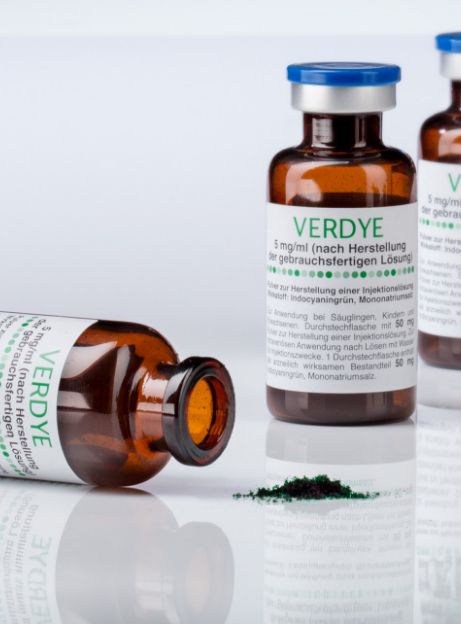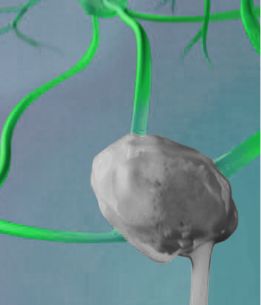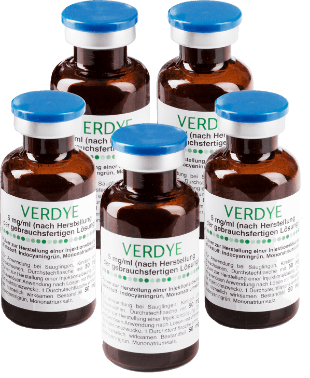Use of Verdye (ICG)
in Breast SLN
Verdye approval for Breast SLN in Spain January 2024
The presence of lymphatic metastases is an important prognostic factor for the survival of breast cancer patients and their identification has a bearing on further treatment.1 Sentinel lymph node biopsy (SLNB) remains a cornerstone in the management of early breast cancer and is the current standard of care for clinically and radiologically node-negative patients.2
Importantly, SLNB enhances patient’s quality of life without compromising diagnostic accuracy or prognostic information for node-negative patients.3 Until recently, the gold standard for SLNB in patients with breast cancer is radio-guided surgery with radioisotope technetium-99m (99mTc) which has a reported sentinel lymph node (SLN) detection rate of 86.4%.4 Some clinicians combine 99mTc with blue dyes such as Methylene Blue dye, increasing the detection rate to 96%-99.8%.4 However, both 99mTc and blue dyes have many associated adverse effects.5,6 In particular, Methylene Blue dye is associated with many devastating effects including soft tissue necrosis, (permanent) skin tattooing at the injection site, metabolic and haematologic side effects making it infrequently utilised for routine surgical care.7 Further, Patent Blue and Isosulphan Blue are associated with increased rates of adverse reactions (0.7% – 1.1% of cases) in comparison to Methylene Blue.8,9 Also, the use of 99mTc imposes a significant burden on patients and hospitals, including the logistical challenges associated with pre-operative administration, risk of exposure to ionising radiation for healthcare professionals, and adherence to regulatory requirements for handling and storage of radio-pharmaceuticals.

Table 1: Compiled results from eight meta-analysis
| ICG | RI 99mTc | BD [9] | |
|---|---|---|---|
| Allergic reactions | Very rare (>1 / 10,000) |
Generalized erythema, urticaria, angioedema |
Soft tissue necrosis, metabolic, and hematologic side effects |
| Dosing | During surgery | Day before | During Surgery |
| SLN detection rates | 96.1% | 86.4% | 85.7% |
| Radiation exposure | None | Yes | None |
| Resource use | High | Low | High |
Significant benefits of using Verdye (ICG)

- Real-time Imaging: ICG provides real-time visualisation, allowing surgeons to precisely identify and remove SLNs during surgery.
- Accuracy: ICG-based SLN detection has been shown to be highly accurate in identifying lymph nodes.10 Requires a small injection only which can be administered whilst patient is anaesthetised, thus minimising patient discomfort.
- Excellent Safety Profile: ICG has a significantly safer profile to blue dyes.*
- Minimal Skin Irritation: Little or no skin tattooing associated with ICG use, compared to blue dyes.6
- No Preoperative Procedure Required: The use of RIs creates logistical challenges for hospitals, legislative requirements, and a risk of radiation exposure for healthcare professionals.
*Based on Diagnostic Green Pharmacovigilance data, a single adverse reaction was identified in 22,248 patients.”

Clinical evidence shows clear
advantages using Verdye (ICG)
A review of eight meta-analyses from 2016-2021 was undertaken, with results shown in Table 2, with a summary of compiled results in Table 3 and Table 4.
Table 2: Results of eight meta-analyses: 2016-202110
| ICG | RI | BD | ||||||||
|---|---|---|---|---|---|---|---|---|---|---|
| 1st author | N (ICG) | Per-case DR |
Sensitivity | Avg. # nodes |
Per-case DR |
Sensitivity | Avg. # nodes |
Per-case DR |
Sensitivity | Avg. # nodes |
| Niebling, 2016 | 628 | 99.4% | NA | 3.23 | 94.0% | NA | NA | 85.0% | NA | NA |
| Zhang, 2016 | 2594 | 98.0% | 92.0% | NA | NA | NA | NA | NA | NA | NA |
| Sugie, 2017 | 1736 | 97.5% | 95.1% | NA | 96.7% | 90.9% | NA | NA | NA | NA |
| Mok, 2019 | 4244 | 97.9% | 99.4% | NA | 96.5% | 97.4% | NA | 86.8% | 81.6% | NA |
| Jeremiasse, 2020 | 3544 | 97.9% | NA | 2.37 | 96.9% | NA | 1.69 | 87.2% | NA | 1.80 |
| Thongvitokomarn, 2020 | 3377 | 97.3% | NA | 2.35 | 96.6% | NA | 1.72 | 87.8% | NA | 1.92 |
| Goonawardena, 2020 | 2277 | 96.5% | 93.7% | 2.09 | 96.9% | 92.0% | 1.79 | NA | NA | NA |
| Kedrzycki, 2021 | 1292 | 97.9% | NA | 1.98 | 84.9% | NA | 1.55 | 77.2% | NA | 1.79 |
| Yin, 2021 | 97.6% | 98.3% | 2.05 | 96.4% | 84.6% | 1.57 | 89.2% | 84.5% | 1.93 | |
| Unweighted avg. | 97.8% | 95.7% | 2.35 | 94.9% | 91.2% | 1.66 | 85.5% | 83.1% | 1.86 | |
Table 3: Compiled results from eight meta-analysis
| Comparison | by > 5.0% | by 2.0 - 4.9% | Total |
|---|---|---|---|
| Superiority of ICG over BD | 11 | 1 | 12 |
| Superiority of ICG over RI | 7 | 3 | 10 |
| Superiority of RI over ICG | 0 | 0 | 0 |
| Superiority of BD over ICG | 0 | 0 | 0 |
Table 4: Compiled results from eight meta-analyses: 2016-2021

Key findings from the meta-analysis concludes that10:
ICG-fluorescence (ICG-F) is clearly superior to blue dye (BD) staining in every metric of SLN detection
ICG-F is clearly non-inferior to both radioisotope (RI)-lymphoscintigraphy and the combination of RI + BD in per-case SLN detection and both per-case and per-node sensitivity/false negative rate (FNR)
ICG-F is clearly superior to both RI and RI+BD in per-node SLN detection
The above-noted findings remain consistent with other published meta-analyses

References
1. Goyal A, Newcombe RG, Chhabra A et al. Factors affecting filed localisation and false negative rates of sentinel node biopsy in breast cancer – results of the ALMANAC validation phase. Brest Cance rREs Tret 2006; 99; 203-208
2. Rao R, Euhus D, Mayo HG et al. Axillary node interventions in breast cancer: a systemic review JAMA 2013; 310: 1385-1394
3. Cykowska A, Marano L, D’Ignazio A et al. New technologies in breast cancer sentinel lymph node biopsy; from the current gold standard to artificial intelligence. Surg Oncol. 2020 Sep;34:324-335. doi: 10.1016/j.suronc.2020.06.005. Epub 2020 Jul 7. PMID: 32791443.
4. Bargon CA, Huibers A, Young-Afat DA et al. Sentinel lymph node mapping in breast cancer patients through fluorescence imaging using Indocyanine green – the Influence Trial, Annals of Surgery Vol 276, No 5, Nov 22 913-920
5. Mazouni C, Koual M, De Leeuw F et al. Prospective evaluation of limitations of near infrared imaging in detecting axillary sentinel lymph modes in primary breast cancer. Breast J 2018; 24:1006-1009
6. Horst Van Der J, Klinkenbijl JHG. Anaphylactis shock after injection of patent blue for sentinel lymph node examination. Ned Tijdschr Geneeskd 2001: 145: 2086-2088
7. Hounschell C, Kilgore L, Pruitt P et al. Evaluation of learning curve with Indocyanine Green (ICG) versus blue dye for sentinel lymph node biopsy in breast cancer, The American Journal of Surgery, Oct 2023 https://www. americanjournalofsurgery.com/article/S0002-9610(23)00508-1/fulltext
8. Wilke LG, McCall LM, Posther KE et al. Surgical complications associated with sentinel lymph node biopsy: results from a prospective international cooperative group trial. Ann Surg Oncol. 2006 Apr;13(4):491-500. doi: 10.1245/ ASO.2006.05.013. Epub 2006 Mar 2. PMID: 16514477.
9. Raut CP, Hunt KK, Akins JS et al. Incidence of anaphylactoid reactions to isosulfan blue dye during breast carcinoma lymphatic mapping in patients treated with preoperative prophylaxis: results of a surgical prospective clinical practice protocol. Cancer. 2005 Aug 15;104(4):692-9. doi: 10.1002/cncr.21226. PMID: 15981283.
10. White KP, Sinagra D, Dip F et al. Indocyanine green fluorescence versus blue dye, technetium-99M, and the dual-marker combination of technetium-99M + blue dye for sentinel lymph node detection in early breast cancer- meta-analysis including consistency analysis. Surgery. 2023 Dec 13:S0039-6060(23)00820-6. doi: 10.1016/j. surg.2023.10.021. Epub ahead of print. PMID: 38097484.
